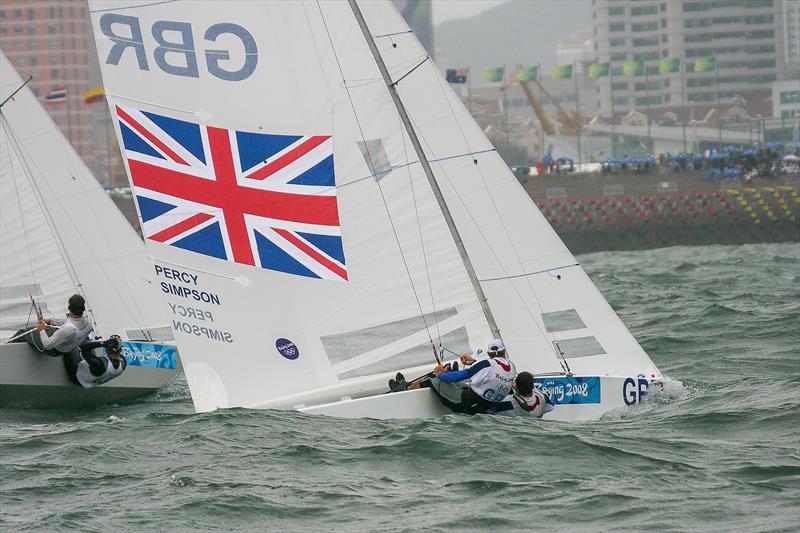
Olympic 2024: Seaworthiness of Olympic classes questioned
by Michele Tognazzi/FareVela 14 Apr 2019 16:43 PDT
15 April 2019

Iain Percy and Andrew (Bart) Simpson drive upwind in the Medal Race at the 2008 Olympic Regatta in torrid conditions to win the Gold Medal -2008 Olympic Regatta, Qingdao © Richard Gladwell


Italian Sailing journalist Michele Tognazzi of FareVela was in Palma for the recent Trofeo Princesa Sofia.
Due to fresh winds (18-25kts) and an awkward but not unsailable sea state, three classes stayed ashore. In this editorial piece Tognazzi raises the issue of seaworthiness of several Olympic classes, and even more concerning is the fact that two classes covering three events are under review by World Sailing for the 2024 Olympics. One - the Finn is already gone.
As has been noted in Sail-World many times in the past, a magnificent and unique opportunity is missed when either there are either no TV cameras on the offshore courses, or the boats aren't sufficiently seaworthy to be able to handle the conditions.
There is an inherent issue with high performance boats that they will "launch" out of the back of some sea states when going to windward. However the factor being overlooked in the total Olympic Sailing package are the strong wind options and how the class mix can be altered on a day to ensure that there are at least some classes that are sufficiently seaworthy to race. As noted there are really only two The Finn and 470 that can be raced in these conditions. Maybe the RS:X is a further option - but they haven't been tested in this situation in the last three Olympics.
In the 2008 Olympic lineup the now dropped classes - the Star and Yngling keelboats and the Tornado multihull sailed on a torrid last day without too many problems. The 49er tried in their Medal Race and every boat in the fleet capsized at least once - allowing a crew which started a few seconds short of five minutes behind the fleet to catch up and win the Gold medal.
Michele Tognazzi reports for FareVela on the Medal Racing in Palma (text auto-translated from Italian).
The Medal Race day was discussed at the recent Princesa Sofia Trophy in Palma. Saturday 6 April, wind at 20-25 knots in the Bay of Palma, a significant wave. Finn, Laser, 470 and windsurfing races. Nacra 17, 49er and FX remain on the ground.
The regatta offers a true spectacle, with glides, splashes, duels between the breakers, moaning muscles and boats that turn into human prostheses. The paradox is that the boats defined as "old and slow" are all in the sea, the "modern and fast" ones all on land. Is that seaworthiness , translatable into Italian as an adjective "marine boat", no longer a value of the new sail that World Sailing is trying to offer? Or rather, is an " Unseaworthiness " chased by very fast boats but which cannot sail with just two meters of wave?
Olympic sailing, and sporting in general, has grown into the myth of great businesses and legendary places: the Star World Championship in Laredo, Cantabria, the Busan Olympics, Korea, the World Championships in Cadiz or Cascais, with the ocean waves that they threw all the mighty breath of the Atlantic into your face. The Soling World Championship in La Baule, Brittany. The waves of Anzio. Port Phillip Bay in Melbourne. The America's Cup in Fremantle. The currents of the English Channel or La Rochelle. Epic feats and tough regattas, where a test lasted almost two hours, with sides in the wind of almost two miles. Or the old Olympic triangles, with the slivers that massacred the arms of the crewmen. The world changes and that's okay. The sticks in the wind have shortened. The abandoned leaves.
Then someone thought that the sailing had to be changed again to become attractive. More and more fast boats, flying, but that have less and less ocean. Extremely enjoyable attractions, but suitable for flat-watered lakes or sheltered bays. And so on, more and more in the warm shelter and less and less in the open sea ... The sail must be brought close to the people, they say. Only those who have never sailed can think that sailing is a discipline to see and not to do. That its charm lies in seeing it rather than experiencing the embrace of wind and sea on a boat and a man in symbiosis. The kites, really cool, are clear, they come out of the sea and slide over it. Water turns into a playground and loses its meaning as a vital element to interpret and live. The sailing videos are more and more centered on caps, glides, circus tumbles. Ephemeral enjoyment from Youtube of the duration of an early orgasm.
The absurd was reached at the Rio 2016 Games, when the ocean races in front of Copacabana were among the most beautiful ever seen in recent times. Wind at 25/28 knots, waves over two meters: Finn, 470 and Laser gave a show but, apart from a few dozen sailors, trainers, photographers and journalists (including the writer) nobody noticed, because so much sought after televisions had decided to resume skiff regattas in flat water and unstable winds within the Bay. The most beautiful images that could be desired, an exceptional spot, simply missed because someone had considered that a weather report could not give valid indications to the effectiveness of a schedule.
A curious fact is that it seems that the lesson is not served. Rather. We continue in the fall, increasingly redefining sailing in which the seamanship and the ability to face the sea are secondary to the ephemeral speed. Mind you, foiling is an exceptional innovation and is fine. Passionate and entertaining, but it cannot be considered the only "new" way to go sailing, as if centuries of sailing evolution were simply considered as technological residues of the last century.
The best sailors in the world, those of the Olympic classes, can and must sail and race in extreme conditions. There are boats that do it, see Finn, 470, Laser or windsurfing as happened in Palma. Others that objectively would be at risk, like the Nacra 17 foiling, which in fact (and appropriately) also want to change some racing rules in order to ensure greater safety, or the 49er. Or take away the Finn who made the history of sailing to put a mixed boat for offshore racing, posing as a coastal with restless calm for the course au large that is so passionate about it. Business is business , but ... is it appropriate for the whole movement?
We remember the historical Medal Race of Qingdao 2008, where the Sibellos lost the Gold for a cap [S-W: The Sibello brothers (ITA) finished tied for the Bronze in the 49er, but lost on a countback. They were only 5pts off Gold] . The monsoon beat hard and all the skiffs overturned at least once. Or another Sofia Trophy a few years ago, when the Nacra not yet foiling before puking at the windward mark waited for the right wave, with surreal seconds on the starboard tack before the decisive moment. Vittorio Bissaro was a master in the maneuver, others ended up diving in the bow. In short, the speed is beautiful. There is no doubt. But also the boats that know and can cope with rough seas are safe.
For the rest of this story visit
farevela.net/2019/04/11/la-vela-olimpica-diventa-unseaworthiness-alcune-considerazioni-sulle-medal-race-di-palma/